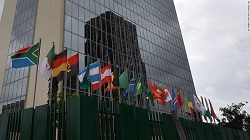
The human face of Logistics

Acting Director of the Namibia German Centre for Logistics, Logan Fransman.
Nepal might seem far away, but we know ourselves all too well in our own region what a humanitarian disaster is all about and are in a sad way experienced in being confronted with them – whether it is floods, droughts or earthquakes or even a major plane crash.
These events all have one thing in common: The people, places and their infrastructure are all compromised. Assistance is required and preferably as speedily as possible. Swiftness of action is of the essence, as lives are at stake.
This is where logistics can and does shine. 70% to 80% of costs to address a humanitarian disaster go into logistics. Getting food, supplies, fresh water, doctors, rescue workers and of course ‘search and rescue’ dogs to the impacted area is of paramount importance. Statistics indicate furthermore that 83% of the victims of natural disasters occur in developing or emerging countries (CRED 2009).
The infrastructure in these countries is often already insufficient under regular circumstances and thus often completely destroyed or damaged during a catastrophe and therefore not accessible to emergency response teams. A good example were the quake in Haiti, that damaged the port, and proved to be a major obstacle in providing supplies as there was nowhere to dock. Roads, airports, even ports may not be accessible. Yet, all the disaster relief goods still need to get to their destination.
Having a solid, well-rehearsed disaster relief plan in place, is essential. Often this is not the case, which adds to the suffering in places where life is already tough at the best of times. Moreover, an inadequate communication facility causes difficulties in coordinating humanitarian aid and logistics.
This is in essence why countries can almost never (an exception to this may have been “Hurricane Katrina”) address and deal with such a crisis alone and why it needs an international humanitarian intervention.
Their task seems simple enough at first sight, a place without food, water and where people are in need of these things, should just be sent them. Drive a truck, send a ship or fly a plane to the affected area and deliver the goods donated by the government, other countries, NGO’s, charities and private individuals.
How hard can it be? In fact it is very difficult as each and every disaster lays bare again. Lack of logistics coordination between partners is often a major issue leading to delays in distribution and overlapping in some activities. The lack of logistics manpower such as volunteers or staff members and no agreements with service providers to provide emergency items all create huge bottle necks. Bottle necks that no one can afford as human lives are at stake. Having people, trained, educated and experienced in logistics and getting the right goods to the right people in the right destination is what it is all about. There is a need to understand the demand in any product supply chain as this becomes even more important when critical supply for relief is required.
The training of local logistics experts in order to increase the preparedness in case of a disaster is the key to disaster relief. The lack of professionalisation of the logistics function is what most organisations lament heavily about.
The unseen and unsung heroes of many disaster relief operations are the men and women that move the goods. No country can ever afford not to have a sufficient number of logisticians, educated and experienced in the field of logistics, who contribute in a real and essential manner to the saving of lives, by simply moving people and things to the places where they are needed and where these critical logistics make a huge difference.












































